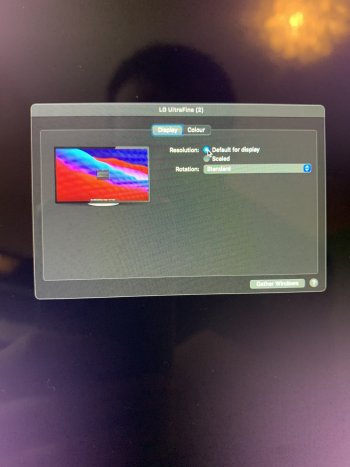Hey everybody, I am new to this forum! I hope you can help me because I am a little bit lost on getting the LG Ultrafine 4k (22MD4KA-B) to work properly on Big Sur and MacBook Pro 2016 with Radeon RX450).
I have been struggling with the following issue:
- the screen shows all the resolutions no problem, but there is no brightness slider whatsoever. I have tried plugging the monitor through the thunderbolt 3 port of the MBP, using TB3 cable, USB-C cable (Using the usb-c LG cable included in the 27 inch 5k LG ultrafine monitor which I also own), TB3 to DisplayPort cable (to a Targus DOCK570EUZ dock in f station), and also Without any other monitor plugged in and with the others, and I can get the full 4096x2304 @60Hz res on all the tests, however the brightness cannot be changed. The monitor is stuck tonmaximu. Brightness and it really is bright - sears my eyes after about one minute lol!
I also have tried adding a second usb cable to the dock as well as to the MBP directly, when trying the docking through usb-c to DP on the targus, as I had read that sometimes controls require a separate usb-c data link, but still no change on that front. No brightness slider is present - see pics. The only way I finally succeeded is by using a TB3 very short cable to the top right TB3 port of the MBP, the slider showed up, I lowered the resolution and then plugged it again in the usual way (through the Targus Dock); the slider disappeared but the brightness setting remained - bizarre!
- the second issue is related to something quite strange I noticed when the system is on screen saver or in operation: the MBP screen and the 5k screen all show the screen saver to be quite smooth and operation and mo loving windows and writing etc is very smooth, whereas the 22MD4KA-B is very very stuttering with a frame transition every 3 seconds which basically makes it unusable as if for example you give a scroll command on a document, it takes almost 2 seconds for the screen to react. SwitchresX and the display properties both show 60Hz refresh, so I am not sure how it could be so stuttering and laggy? Any idea?
Thanks so much in advance!
D
I have been struggling with the following issue:
- the screen shows all the resolutions no problem, but there is no brightness slider whatsoever. I have tried plugging the monitor through the thunderbolt 3 port of the MBP, using TB3 cable, USB-C cable (Using the usb-c LG cable included in the 27 inch 5k LG ultrafine monitor which I also own), TB3 to DisplayPort cable (to a Targus DOCK570EUZ dock in f station), and also Without any other monitor plugged in and with the others, and I can get the full 4096x2304 @60Hz res on all the tests, however the brightness cannot be changed. The monitor is stuck tonmaximu. Brightness and it really is bright - sears my eyes after about one minute lol!
I also have tried adding a second usb cable to the dock as well as to the MBP directly, when trying the docking through usb-c to DP on the targus, as I had read that sometimes controls require a separate usb-c data link, but still no change on that front. No brightness slider is present - see pics. The only way I finally succeeded is by using a TB3 very short cable to the top right TB3 port of the MBP, the slider showed up, I lowered the resolution and then plugged it again in the usual way (through the Targus Dock); the slider disappeared but the brightness setting remained - bizarre!
- the second issue is related to something quite strange I noticed when the system is on screen saver or in operation: the MBP screen and the 5k screen all show the screen saver to be quite smooth and operation and mo loving windows and writing etc is very smooth, whereas the 22MD4KA-B is very very stuttering with a frame transition every 3 seconds which basically makes it unusable as if for example you give a scroll command on a document, it takes almost 2 seconds for the screen to react. SwitchresX and the display properties both show 60Hz refresh, so I am not sure how it could be so stuttering and laggy? Any idea?
Thanks so much in advance!
D




